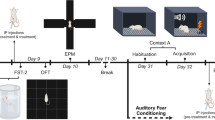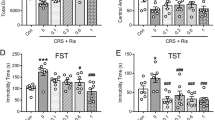Abstract
Rationale
Abnormalities of glutamatergic neurotransmission have been reportedly observed in psychiatric disorders. Previously, we demonstrated that (1R, 2R, 3R, 5R, 6R)-2-Amino-3-(3,4-dichlorobenzyloxy)-6-fluorobicyclo[3.1.0]hexane-2,6-dicarboxylic acid (MGS0039) is a selective antagonist for group II metabotropic glutamate receptors (mGluR2/3), and that it exerted antidepressant effects in some animal behavioral tests.
Objectives
In the present study, we provide additional evidence that MGS0039 exhibits antidepressant and anxiolytic effects in experimental rodent models, which are predictive of clinical efficacy.
Methods
The learned helplessness (LH) paradigm, which is a common model used to examine the depressive state, was used to assess antidepressant effects of MGS0039. Moreover, anxiolytic effects of MGS0039 were investigated in the conditioned fear stress (CFS) model, which represents emotional abnormality, including anxiety.
Results
Intraperitoneal administration of MGS0039 (10 mg/kg) to rats for 7 days elicited a significant reduction in escape failures in the LH paradigm. In addition, rats treated with MGS0039 (2 mg/kg) showed significantly attenuated freezing behavior in a CFS model, indicating the anxiolytic-like potential of MGS0039.
Conclusions
These results suggest that the blockade of mGluR2/3 with MGS0039 may be effective in the treatment of depressive and anxiety disorders.


Similar content being viewed by others
References
Bergink V, Westenberg HG (2005) Metabotropic glutamate II receptor agonists in panic disorder: a double blind clinical trial with LY354740. Int Clin Psychopharmacol 20:291–293
Campeau S, Miserendino MJ, Davis M (1992) Intra-amygdala infusion of the N-methyl-d-aspartate receptor antagonist AP5 blocks acquisition but not expression of fear-potentiated startle to an auditory conditioned stimulus. Behav Neurosci 106:569–574
Carlsson ML (2001) On the role of prefrontal cortex glutamate for the antithetical phenomenology of obsessive compulsive disorder and attention deficit hyperactivity disorder. Prog Neuropsychopharmacol Biol Psychiatry 25:5–26
Cartmell J, Monn JA, Schoepp DD (1999) The metabotropic glutamate 2/3 receptor agonists LY354740 and LY379268 selectively attenuate phencyclidine versus d-amphetamine motor behaviors in rats. J Pharmacol Exp Ther 291:161–170
Chaki S, Yoshikawa R, Hirota S, Shimazaki T, Maeda M, Kawashima N, Yoshimizu T, Yasuhara A, Sakagami K, Okuyama S, Nakanishi S, Nakazato A (2004) MGS0039: a potent and selective group II metabotropic glutamate receptor antagonist with antidepressant-like activity. Neuropharmacology 46:457–467
Clinton SM, Haroutunian V, Davis KL, Meador-Woodruff JH (2003) Altered transcript expression of NMDA receptor-associated postsynaptic proteins in the thalamus of subjects with schizophrenia. Am J Psychiatry 160:1100–1109
Conn PJ, Pin JP (1997) Pharmacology and functions of metabotropic glutamate receptors. Annu Rev Pharmacol Toxicol 37:205–237
Fanselow MS (1980) Conditioned and unconditioned components of postshock freezing. Pavlovian J Biol Sci 15:177–182
Fanselow MS, Hemstetter FJ (1988) Conditional analgesia, defensive freezing, and benzodiazepines. Behav Neurosci 102:233–243
Gambarana C, Ghiglieri O, Taddei I, Tagliamonte A, De Montis MG (1995) Imipramine and fluoxetine prevent the stress-induced escape deficits in rats through a distinct mechanism of action. Behav Pharmacol 6:66–73
Graeff EO, Hunziker MH, Graeff FG (1989) Effects of ipsapirone and BAYR1531 on learned helplessness. Braz J Med Biol Res 22:1141–1144
Greenslade RG, Mitchell SN (2004) Selective action of (−)-2-oxa-4-aminobicyclo[3.1.0]hexane-4,6-dicarboxylate (LY379268), a group II metabotropic glutamate receptor agonist, on basal and phencyclidine-induced dopamine release in the nucleus accumbens shell. Neuropharmacology 47:1–8
Grillon C, Cordova J, Levine LR, Morgan CA 3rd (2003) Anxiolytic effects of a novel group II metabotropic glutamate receptor agonist (LY354740) in the fear-potentiated startle paradigm in humans. Psychopharmacology 168:446–454
Hashimoto S, Inoue T, Koyama T (1996) Serotonin reuptake inhibitors reduce conditioned fear stress-induced freezing behavior in rats. Psychopharmacology 123:182–186
Hashimoto S, Inoue T, Koyama T (1999) Effects of conditioned fear stress on serotonin neurotransmission and freezing behavior in rats. Eur J Pharmacol 378:23–30
Helton DR, Tizzano JP, Monn JA, Schoepp DD, Kallman MJ (1998) Anxiolytic and side-effect profile of LY354740: a potent, highly selective, orally active agonist for group II metabotropic glutamate receptors. J Pharmacol Exp Ther 284:651–660
Inoue T, Tsuchiya K, Koyama T (1996) Serotonergic activation reduces defensive freezing in the conditioned fear paradigm. Pharmacol Biochem Behav 53:825–831
Inoue T, Li XB, Abekawa T, Kitaichi Y, Izumi T, Nakagawa S, Koyama T (2004) Selective serotonin reuptake inhibitor reduces conditioned fear through its effect in the amygdale. Eur J Pharmacol 497:311–316
Kalin NH, Sherman JE, Takahashi LK (1988) Antagonism of endogenous CRH systems attenuates stress-induced freezing behavior in rats. Brain Res 457:130–135
Karasawa J, Shimazaki T, Kawashima N, Chaki S (2005) AMPA receptor stimulation mediates the antidepressant-like effect of a group II metabotropic glutamate receptor antagonist. Brain Res 1042:92–98
Karasawa J, Yoshimizu T, Chaki S (2006) A metabotropic glutamate 2/3 receptor antagonist, MGS0039, increases extracellular dopamine levels in the nucleus accumbens shell. Neurosci Lett 393:127–130
Kawashima N, Karasawa J, Shimazaki T, Chaki S, Okuyama S, Yasuhara A, Nakazato A (2005) Neuropharmacological profiles of antagonists of group II metabotropic glutamate receptors. Neurosci Lett 378:131–134
Kellner M, Muhtz C, Stark K, Yassouridis A, Arlt J, Wiedemann K (2005) Effects of a metabotropic glutamate(2/3) receptor agonist (LY544344/LY354740) on panic anxiety induced by cholecystokinin tetrapeptide in healthy humans: preliminary results. Psychopharmacology 179:310–315
Kim M, Campeau S, Falls WA, Davis M (1993) Infusion of the non-NMDA receptor antagonist CNQX into the amygdala blocks the expression of fear-potentiated startle. Behav Neural Biol 59:5–8
Malberg JE, Duman RS (2003) Cell proliferation in adult hippocampus is decreased by inescapable stress: reversal by fluoxetine treatment. Neuropsychopharmacology 28:1562–1571
Mangiavacchi S, Masi F, Scheggi S, Leggio B, De Montis MG, Gambarana C (2001) Long-term behavioral and neurochemical effects of chronic stress exposure in rats. J Neurochem 79:1113–1121
Martin P, Soubrie P, Puech AJ (1990) Reversal of helpless behavior by serotonin uptake blockers in rats. Psychopharmacology 101:403–407
McCullumsmith RE, Meador-Woodruff JH (2002) Striatal excitatory amino acid transporter transcript expression in schizophrenia, bipolar disorder, and major depressive disorder. Neuropsychopharmacology 26:368–375
Moghaddam B, Adams BW (1998) Reversal of phencyclidine effects by a group II metabotropic glutamate receptor agonist in rats. Science 281:1349–1352
Moghaddam B, Adams B, Verma A, Daly D (1997) Activation of glutamatergic neurotransmission by ketamine: a novel step in the pathway from NMDA receptor blockade to dopaminergic and cognitive disruptions associated with the prefrontal cortex. J Neurosci 17:2921–2927
Miserendino MJ, Sananes CB, Melia KR, Davis M (1990) Blocking of acquisition but not expression of conditioned fear-potentiated startle by NMDA antagonists in the amygdala. Nature 345:708–716
Nakazato A, Sakagami K, Yasuhara A, Ohta H, Yoshikawa R, Itoh M, Nakamura M, Chaki S (2004) Synthesis, in vitro pharmacology, structure-activity relationships, and pharmacokinetics of 3-alkoxy-2-amino-6-fluorobicyclo[3.1.0]hexane-2,6-dicarboxylic acid derivatives as potent and selective group II metabotropic glutamate receptor antagonists. J Med Chem 47:4570–4587
Newton SS, Thome J, Wallace TL, Shirayama Y, Schlesinger L, Sakai N, Chen J, Neve R, Nestler EJ, Duman RS (2002) Inhibition of cAMP response element-binding protein or dynorphin in the nucleus accumbens produces an antidepressant-like effect. J Neurosci 22:10883–10890
Petty F, Sherman AD (1983) Learned helplessness induction decreases in vivo cortical serotonin release. Pharmacol Biochem Behav 18:649–650
Petty F, Kramer G, Wilson L (1992) Prevention of learned helplessness: in vivo correlation with cortical serotonin. Pharmacol Biochem Behav 43:361–367
Rosenberg DR, MacMaster FP, Keshavan MS, Fitzgerald KD, Stewart CM, Moore GJ (2000) Decrease in caudate glutamatergic concentrations in pediatric obsessive–compulsive disorder patients taking paroxetine. J Am Acad Child Adolesc Psychiatry 39:1096–1103
Santarelli L, Saxe M, Gross C, Surget A, Battaglia F, Dulawa S, Weisstaub N, Lee J, Duman R, Arancio O, Belzung C, Hen R (2003) Requirement of hippocampal neurogenesis for the behavioral effects of antidepressants. Science 301:805–809
Schoepp DD, Wright RA, Levine LR, Gaydos B, Potter WZ (2003) LY354740, an mGlu2/3 receptor agonist as a novel approach to treat anxiety/stress. Stress 6:189–197
Seligman ME (1978) Learned helplessness as a model of depression. Comment and integration. J Abnorm Psychol 87:165–179
Seligman ME, Beagley G (1975) Learned helplessness in the rat. J Comp Physiol Psychol 88:534–541
Sherman AD, Petty F (1982) Additivity of neurochemical changes in learned helplessness and imipramine. Behav Neural Biol 35:344–353
Sherman AD, Sacquitne JL, Petty F (1982) Specificity of the learned helplessness model of depression. Pharmacol Biochem Behav 16:449–454
Shimazaki T, Iijima M, Chaki S (2004) Anxiolytic-like activity of MGS0039, a potent group II metabotropic glutamate receptor antagonist, in a marble-burying behavior test. Eur J Pharmacol 501:121–125
Stanek L, Walker DL, Davis M (2002) Amygdala infusion of LY354740, a group II metabotropic receptor agonist, blocks fear-potentiated startle in rats. Soc Neurosci Abstr 26:2020
Walker DL, Davis M (1997) Double dissociation between the involvement of the bed nucleus of the stria terminalis and the central nucleus of the amygdala in startle increases produced by conditioned versus unconditioned fear. J Neurosci 17:9375–9383
Walker DL, Davis M (2002) The role of amygdala glutamate receptors in fear learning, fear-potentiated startle, and extinction. Pharmacol Biochem Behav 71:379–392
Yoshimizu T, Chaki S (2004) Increased cell proliferation in the adult mouse hippocampus following chronic administration of group II metabotropic glutamate receptor antagonist, MGS0039. Biochem Biophys Res Commun 315:493–496
Author information
Authors and Affiliations
Corresponding author
Rights and permissions
About this article
Cite this article
Yoshimizu, T., Shimazaki, T., Ito, A. et al. An mGluR2/3 antagonist, MGS0039, exerts antidepressant and anxiolytic effects in behavioral models in rats. Psychopharmacology 186, 587–593 (2006). https://doi.org/10.1007/s00213-006-0390-7
Received:
Accepted:
Published:
Issue Date:
DOI: https://doi.org/10.1007/s00213-006-0390-7




